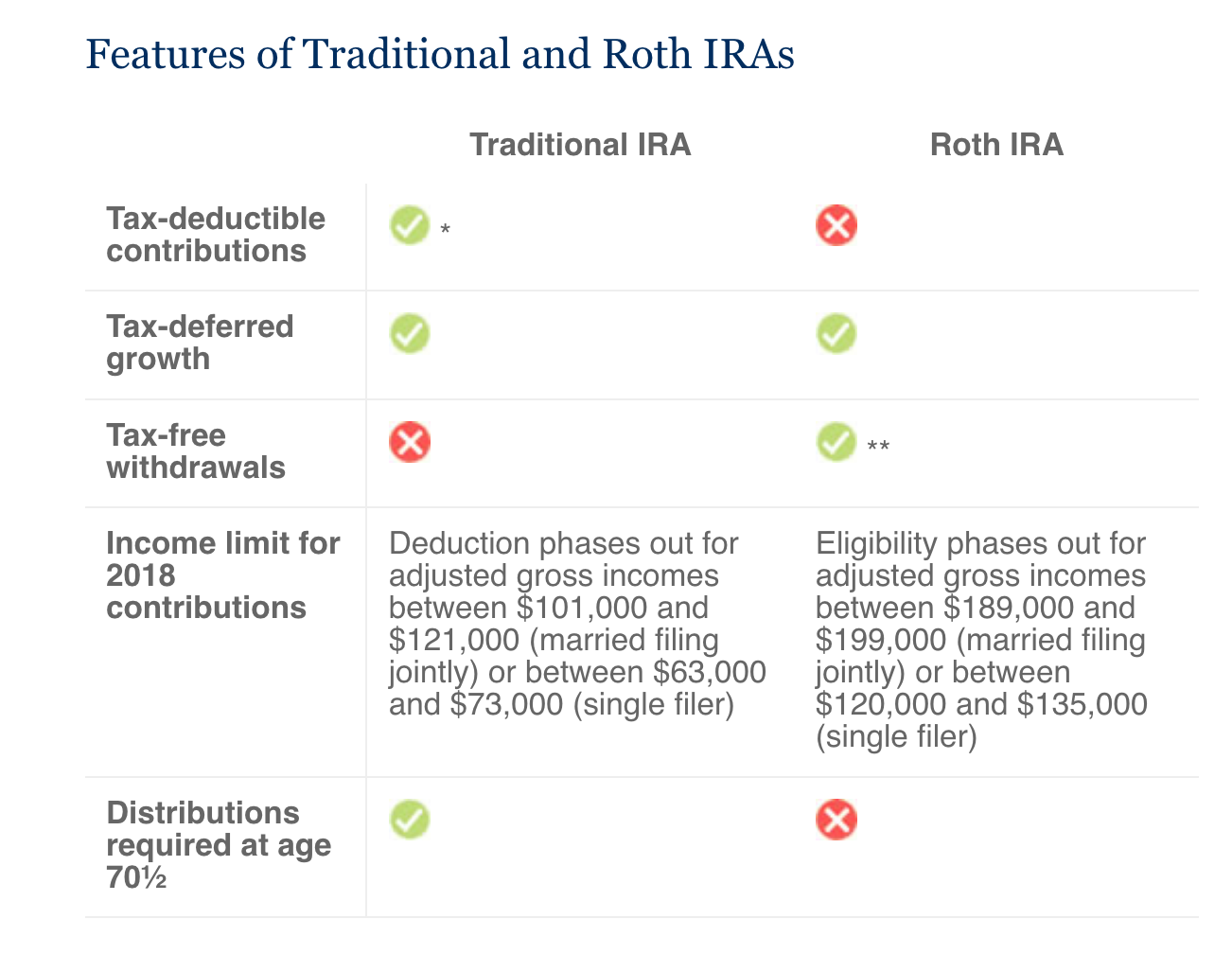Fast Fact: Wealthy Owners. The higher your income is, the more likely you are to have an IRA. Of households with incomes of $50,000 or more—39% own traditional IRAs and 30% own Roth IRAs. Of households with $50,000 or less in income, 13% own traditional IRAs and 6% own Roth IRAs.
Source: Investment Company Institute, 2018
Traditional IRAs, which were created in 1974, are owned by roughly 35.1 million U.S. households. And Roth IRAs, created as part of the Taxpayer Relief Act in 1997, are owned by nearly 24.9 million households. 1
Both are IRAs. And yet each is quite different.
Up to certain limits, traditional IRAs allow individuals to make tax-deductible contributions into the account. Distributions from traditional IRAs are taxed as ordinary income and, if taken before age 59Ω, may be subject to a 10% federal income tax penalty. 2
For individuals covered by a retirement plan at work the deduction for a traditional IRA in 2018 is phased out for incomes between $101,000 and $121,000 for married couples filing jointly, and between $63,000 and $73,000 for single filers.
Piggy bank
Also within certain limits, individuals can make contributions to a Roth IRA with after-tax dollars. To qualify for a tax-free and penalty-free withdrawal of earnings, Roth IRA distributions must meet a five-year holding requirement and occur after age 59 1/2. 3
Like a traditional IRA, contributions to a Roth IRA are limited based on income. For 2018, contributions to a Roth IRA are phased out between $189,000 and $199,000 for married couples filing jointly and between $120,000 and $135,000 for single filers.
In addition to contribution and distribution rules, there are limits on how much can be contributed to either IRA. In fact, these limits apply to any combination of IRAs; that is, workers cannot put more than $5,500 per year into their Roth and traditional IRAs combined. So, if a worker contributed $3,500 in a given year into a traditional IRA, contributions to a Roth IRA would be limited to $2,000 in that same year. 4
Individuals who reach age 50 or older by the end of the tax year can qualify for “catch-up” contributions. The combined limit for these is $6,500. 5
Fast Fact: Wealthy Owners. The higher your income is, the more likely you are to have an IRA. Of households with incomes of $50,000 or more—39% own traditional IRAs and 30% own Roth IRAs. Of households with $50,000 or less in income, 13% own traditional IRAs and 6% own Roth IRAs. Source: Investment Company Institute, 2018
If you meet the income requirements, both traditional and Roth IRAs can play a part in your retirement plans. And once you’ve figured out which will work better for you, only one task remains: open an account
* Up to certain limits
** To qualify, Roth IRA distributions must meet a five-year holding requirement and occur after age 59 1/2.
1. Investment Company Institute, 2018
2. Generally, once you reach age 70 1/2, you must begin taking required minimum distributions from a traditional IRA.
3,4,5. Internal Revenue Service, 2018. The Tax Cuts and Jobs Act of 2017 eliminated the ability to “undo” a Roth conversion.
The content is developed from sources believed to be providing accurate information. The information in this material is not intended as tax or legal advice. It may not be used for the purpose of avoiding any federal tax penalties. Please consult legal or tax professionals for specific information regarding your individual situation. This material was developed and produced by FMG Suite to provide information on a topic that may be of interest. FMG Suite is not affiliated with the named broker-dealer, state- or SEC-registered investment advisory firm. The opinions expressed and material provided are for general information, and should not be considered a solicitation for the purchase or sale of any security. Copyright 2018 FMG Suite.
DISCLAIMER: This website is for informational purposes only and does not constitute a complete description of our investment advisory services or any past performance. This website is neither a solicitation nor an offer to sell securities or investment advisory services except where we are appropriately registered or exempt from such registration. Information throughout this site, whether stock quotes, charts, articles, or any other statement or statements regarding market or other financial information, is obtained from sources which we and our suppliers believe to be reliable. However, we do not warrant or guarantee the timeliness or accuracy of this information. Nothing on this website should be interpreted to state or imply that past results are any indication of future performance. THERE ARE NO WARRANTIES, EXPRESSED OR IMPLIED, AS TO ACCURACY, COMPLETENESS, OR RESULTS OBTAINED FROM ANY INFORMATION POSTED ON THIS OR ANY ‘LINKED’ WEBSITE.
Back




